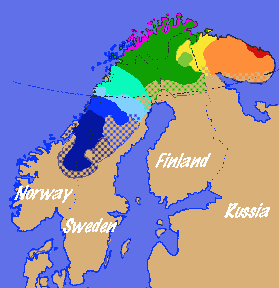Let's see what's out there about Sámi
Sámi language
Árran - Sámi culture and news blog
Oahpa
Lohkan
Gulahalan
Isak saba senteret
North Sámi word list
Partial Swadesh list for North Sámi
Omniglot's North Sámi
Etymological database of the Sámi languages
Games and such - in Norwegian
Some more games
Northern Sámi in Wiktionary
Saamic profile at Learn Any Language
Unilang Sámi
Davvisamégiell grammar
Here's some worksheets
Yle Areena has some tv shows, like news, in North Sámi
(If you find nothing, search with "Oddasat", which is "News" in Sámi)
Yle Sapmi
Wikipedia in Sámi :-D
About Sámi culture
The Sami languages are spoken across northern Scandinavia (Norway and Sweden), Finland and Russia by more than 20 thousand people.
There are nine Sami languages, six of which are written:
Davvi or Northern Sami (about 21.000 speakers)
Inari Sami (300)
Skolt Sami (420)
Kildin Sami (500)
Åarjel or Southern Sami (600)
Lule Sami (2000)
The other Sami languages all have less than 20 speakers,
Ter Sami
Pite Sami
Umea Sami
When I think about this I wish I was really, really, really rich, so that I could buy Kuola from Russia, and Lapland from Norway and Sweden (okay, Finland too) and make Sapmi independent... I am ashamed by being a member of an occupying force, about what we - Finns, Russians, Norwegians and Swedes - to the Sámi people, how we have forced them to give up their religion, language, culture, traditions, to take on ours, which is supposed to be better, somehow... At the same time we have exploited their lands and waters, built water plants and mined and done all kinds of stuff like that. Real, proper imperialistic swine...
Now, I am going to study mainly the Northern Sámi, which is the biggest language/dialect spoken in Finland and Sweden. We have news in Sámi in television, and it would be nice to understand what they say.
Northern Sámi is a SVO language.
The alphabet has 29 letters:
Here's how they are pronounced.
"Northern Sami is an agglutinative, highly inflected language that shares many grammatical features with the other Uralic languages. Sami has also developed considerably into the direction of fusional and inflected morphology, much like Estonian to which it is distantly related. Therefore, morphemes are marked not only by suffixes but also by morphophonological modifications to the root. Of the various morphophonological alterations, the most important and complex is the system of consonant gradation."
Yep, quite a lot like Finnish and Estonian.
Sámi has 7 cases, 3 numbers - singular, plural and dual - they have pronouns expressing that there are two of us doing things... or two of you, or two of them. :-) I like that.
3 persons, 4 moods, 4 tenses and 1 gender. Simple.
Numbers in Northern Sámi
1 - okta
2 - guokte
3 - golbma
4 - njeallje
5 - vihtta
6 - guhtta
7 - čieža
8 - gávcci
9 - ovcci
10 - logi
11 - oktanuppelohkái
12 - guoktenuppelohkái
13 - golbmanuppelohkái
14 - njealljenuppelohkái
15 - vihttanuppelohkái
16 - guhttanuppelohkái
17 - čiežanuppelohkái
18 - gávccinuppelohkái
19 - ovccinuppelohkái
20 - guoktelogi
21 - guoktelogiokta
22 - guoktelogiguokte
23 - guoktelogigolbma
30 - golbmalogi
40 - njealljelogi
50 - vihttalogi
60 - guhttalogi
70 - čiežalogi
80 - gávccilogi
90 - ovccilogi
100 - čuođi
1000 - duhat
Meeting, greeting and being polite
Hello/hi: Heior Buorre beaivvi
Good morning: Buorre idit
Good evening: Buorre eahket
Good night: Buorre idja
How are you: Mii gul'lo?
Very well, thank you.: Buorre, giittus eatnat.
Goodbye: Oaidnaleapmái
Thank you: Giittus / Giittus eatnat
I don't understand: Mun in ádde
I don't know: In diede
Yes: Joo
No: Ii
Excuse me/sorry: Ándagassii
That doesn't matter/No problems: Ii das mihkkege


No comments:
Post a Comment